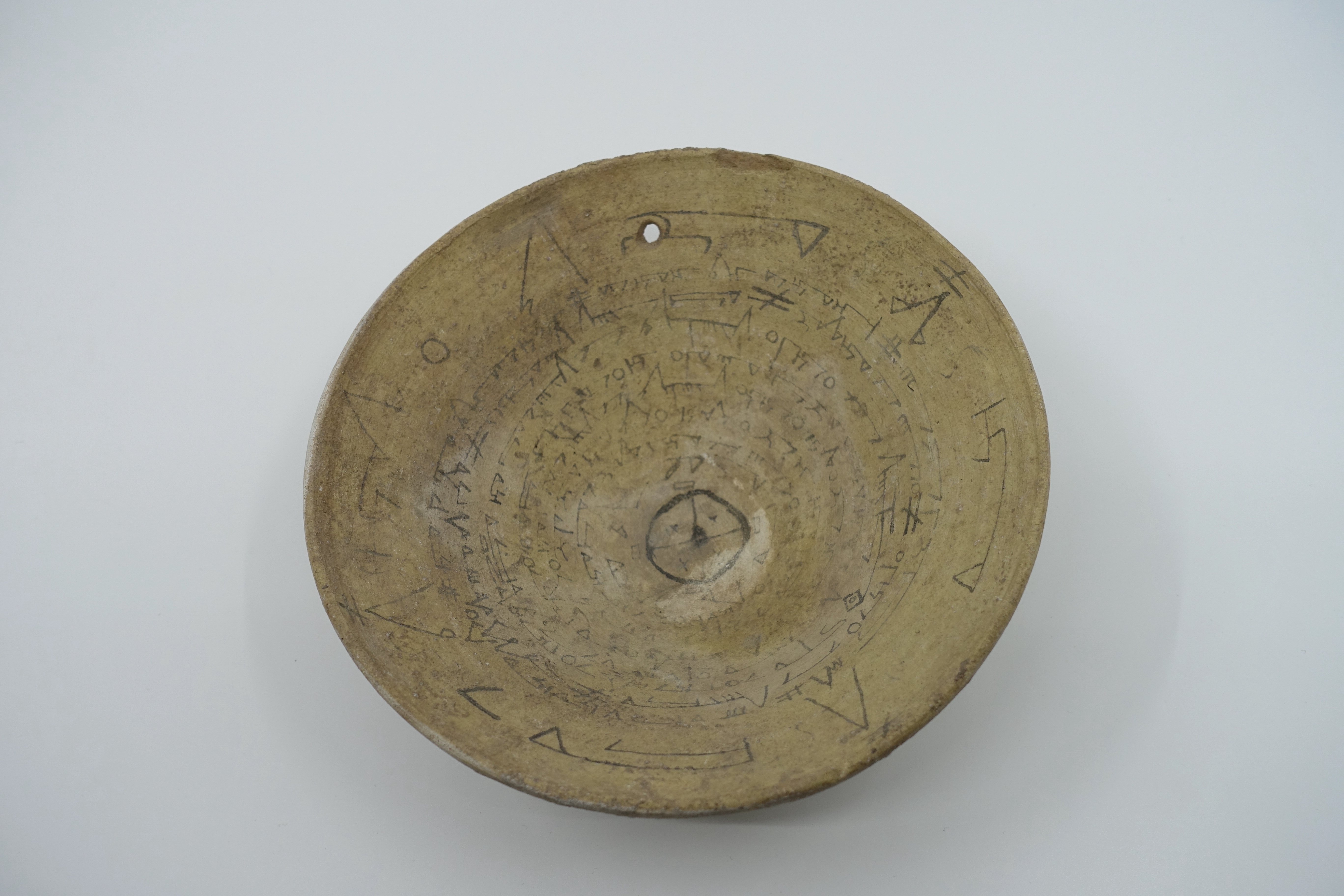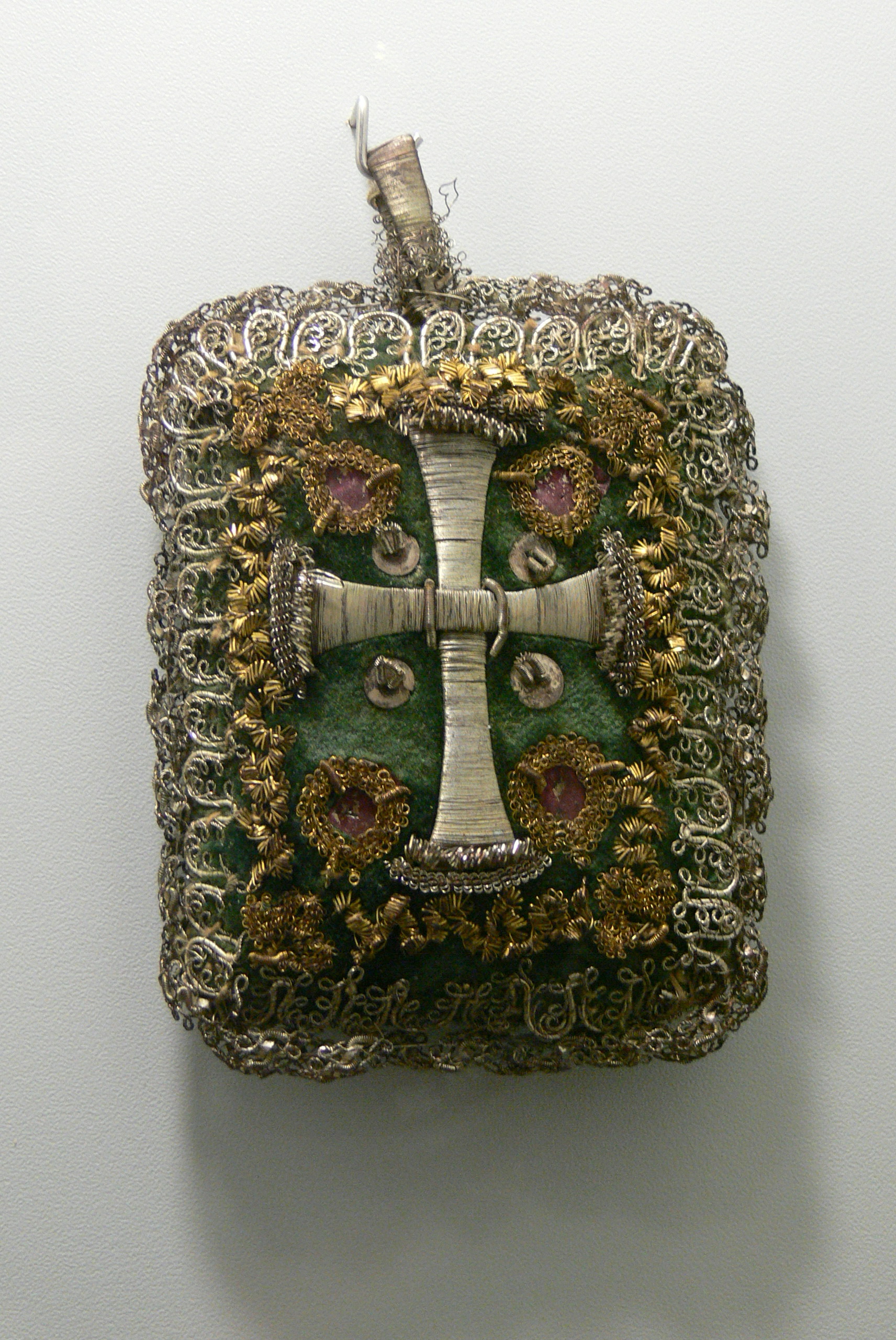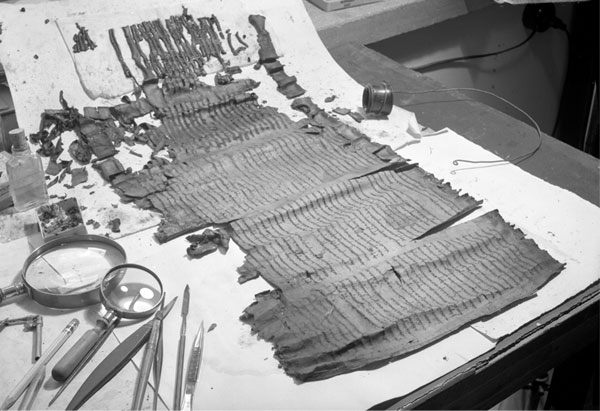|
Skandola
The skandola (literally meaning "dwelling of evil") is a ritual talismanic seal used by Mandaeans to protect against evil. Description The skandola is an iron ring with a chain attached to an iron knife. It is used as a sacred talismanic seal. It is used to seal graves and also newborn babies on their navels. During wedding ceremonies, a priest gives the skandola to the bridegroom. There are incised depictions of the following animals: *Lion, representing Krun *Scorpion, representing Hag *Black snake or serpent, representing Ur *Wasp or hornet E. S. Drower notes parallels with Mithraic bas-reliefs, Yazidism, Iranian artistic symbols, and others. A Mandaean priest told Drower that the skandola was originally brought by Hibil Ziwa from the World of Darkness as he was taking Ruha along with him (a narrative found in Book 5, Chapter 1 of the '' Right Ginza''). See also *Talisman *Hamsa The ''hamsa'' ( ar, خمسة, khamsa) is a palm-shaped amulet popular throughout Nort ... [...More Info...] [...Related Items...] OR: [Wikipedia] [Google] [Baidu] |
Mandaean Priest
A Mandaean priest or ''Rabbi'' refers to an ordained religious leader in Mandaeism. Overview All priests must undergo lengthy ordination ceremonies, beginning with tarmida initiation. Mandaean religious leaders and copyists of religious texts hold the title ''Rabbi'' or in Arabic 'Sheikh'. All Mandaean communities traditionally require the presence of a priest, since priests are required to officiate over all important religious rituals, including masbuta, masiqta, birth and wedding ceremonies. Priests also serve as teachers, scribes, and community leaders. Unfortunately, many Mandaean diaspora communities do not have easy access to priests. Names In Mandaean scriptures, priests are referred to as ''Naṣuraiia'' ( myz, ࡍࡀࡑࡅࡓࡀࡉࡉࡀ, lit= Naṣoraeans) or occasionally as ''Tarmiduta''. On the other hand, laypeople are referred to as ''Mandaiia'' ( myz, ࡌࡀࡍࡃࡀࡉࡉࡀ, lit=Gnostics, Knowers, Enlightened Ones). ''Naṣuraiia'' are considered to have ''naṣ ... [...More Info...] [...Related Items...] OR: [Wikipedia] [Google] [Baidu] |
Talisman
A talisman is any object ascribed with religious or magical powers intended to protect, heal, or harm individuals for whom they are made. Talismans are often portable objects carried on someone in a variety of ways, but can also be installed permanently in architecture. Talismans are closely linked with amulets, fulfilling many of the same roles, but a key difference is in their form and materiality, with talismans often taking the form of objects (eg., clothing, weaponry, or parchment) which are inscribed with magic texts. Talismans have been used in many civilizations throughout history, with connections to astrological, scientific, and religious practices; but the theory around preparation and use has changed in some cultures with more recent, new age, talismanic theory. Talismans are used for a wide array of functions, such as: the personal protection of the wearer, loved ones or belongings, aiding in fertility, and helping crop production. Etymology The word ''talisman'' c ... [...More Info...] [...Related Items...] OR: [Wikipedia] [Google] [Baidu] |
Demons In Mandaeism
In Mandaeism, various beings inhabit the World of Darkness. Types According to the '' Right Ginza'', the World of Darkness consists of many demons, dewis, and evil spirits, including: The ''Right Ginza'' describes them as: Demons in the ''Ginza Rabba'' Main demons Other than Ur, Ruha and her entourage of the 7 planets and 12 constellations, some infernal beings mentioned in the ''Ginza Rabba'' are: *Anathan (Anatan) – husband of Qin; described as a "warrior" and "war-like" in Book 5, Chapter 1 of the '' Right Ginza'' *Gaf and Gafan (Gap and Gapan) * Giu (Giuo) *Hag and Mag (Hagh and Magh) – a male and female pair of demons, respectively *Krun (Karun) *Qin – queen of darkness, mother of Ruha, grandmother of Ur; one of her epithets is Sumqaq *Shdum (Ashdum) – a ruler of the underworld *Zahreil (Zahrʿil) – daughter of Qin and wife of Hibil Ziwa *Zartai-Zartanai Minor demons Other demons mentioned in the ''Ginza Rabba'' are: *Aṭirpan (Aṭarpan), literally "f ... [...More Info...] [...Related Items...] OR: [Wikipedia] [Google] [Baidu] |
Talismans
A talisman is any object ascribed with religious or magical powers intended to protect, heal, or harm individuals for whom they are made. Talismans are often portable objects carried on someone in a variety of ways, but can also be installed permanently in architecture. Talismans are closely linked with amulets, fulfilling many of the same roles, but a key difference is in their form and materiality, with talismans often taking the form of objects (eg., clothing, weaponry, or parchment) which are inscribed with magic texts. Talismans have been used in many civilizations throughout history, with connections to astrological, scientific, and religious practices; but the theory around preparation and use has changed in some cultures with more recent, new age, talismanic theory. Talismans are used for a wide array of functions, such as: the personal protection of the wearer, loved ones or belongings, aiding in fertility, and helping crop production. Etymology The word ''talisman'' c ... [...More Info...] [...Related Items...] OR: [Wikipedia] [Google] [Baidu] |
Hamsa
The ''hamsa'' ( ar, خمسة, khamsa) is a palm-shaped amulet popular throughout North Africa and in the Middle East and commonly used in jewellery and wall hangings.Bernasek et al., 2008p. 12Sonbol, 2005pp. 355–359 Depicting the open right hand, an image recognized and used as a sign of protection in many times throughout history, the ''hamsa'' has been traditionally believed to provide defense against the evil eye. ''Khamsah'' is an Arabic word that means "five", but also refers to images of "the five fingers of the hand".Zenner, 1988p. 284World Institute for Advanced Phenomenological Research and Learning (Belmont, Estados Unidos), 1991p. 219Drazin, 2009p. 268 In Jewish culture, the ''hamsa'' is associated with the number five because of the five fingers depicted on the hand, and because the word ''khamsa'' is cognate to the Hebrew ''ḥamishah'' (חֲמִישָׁה), which also means "five." The ''Hamsa'' has also been known as the Hand of Fatima after the daughter of M ... [...More Info...] [...Related Items...] OR: [Wikipedia] [Google] [Baidu] |
Talisman
A talisman is any object ascribed with religious or magical powers intended to protect, heal, or harm individuals for whom they are made. Talismans are often portable objects carried on someone in a variety of ways, but can also be installed permanently in architecture. Talismans are closely linked with amulets, fulfilling many of the same roles, but a key difference is in their form and materiality, with talismans often taking the form of objects (eg., clothing, weaponry, or parchment) which are inscribed with magic texts. Talismans have been used in many civilizations throughout history, with connections to astrological, scientific, and religious practices; but the theory around preparation and use has changed in some cultures with more recent, new age, talismanic theory. Talismans are used for a wide array of functions, such as: the personal protection of the wearer, loved ones or belongings, aiding in fertility, and helping crop production. Etymology The word ''talisman'' c ... [...More Info...] [...Related Items...] OR: [Wikipedia] [Google] [Baidu] |
World Of Darkness (Mandaeism)
In Mandaeism, the World of Darkness ( myz, ࡀࡋࡌࡀ ࡖࡄࡔࡅࡊࡀ, translit=alma ḏ-hšuka) is the underworld located below Tibil (Earth). It is ruled by its king Ur (Leviathan) and its queen Ruha, mother of the seven planets and twelve constellations. Description The great dark Ocean of Sup (or Suf) lies in the World of Darkness. The great dividing river of Hitpun, analogous to the river Styx in Greek mythology, separates the World of Darkness from the World of Light. Siniawis is one of the regions of the World of Darkness. The ''Ginza Rabba'' mention the Abaddons ( myz, ʿbdunia) as part of the World of Darkness. The '' Right Ginza'' mentions the existence of the "upper Abaddons" () as well as the "lower Abaddons" (). The World of Darkness is sometimes referred to as Sheol ( myz, šiul) in the ''Ginza Rabba'' and other Mandaean scriptures. Inhabitants Various beings inhabit the World of Darkness. See also *Sheol *Ancient Mesopotamian underworld The ancie ... [...More Info...] [...Related Items...] OR: [Wikipedia] [Google] [Baidu] |
Snakes In Religion
Snakes are elongated, limbless, carnivorous reptiles of the suborder Serpentes . Like all other squamates, snakes are ectothermic, amniote vertebrates covered in overlapping scales. Many species of snakes have skulls with several more joints than their lizard ancestors, enabling them to swallow prey much larger than their heads (cranial kinesis). To accommodate their narrow bodies, snakes' paired organs (such as kidneys) appear one in front of the other instead of side by side, and most have only one functional lung. Some species retain a pelvic girdle with a pair of vestigial claws on either side of the cloaca. Lizards have evolved elongate bodies without limbs or with greatly reduced limbs about twenty-five times independently via convergent evolution, leading to many lineages of legless lizards. These resemble snakes, but several common groups of legless lizards have eyelids and external ears, which snakes lack, although this rule is not universal (see Amphisbaenia, ... [...More Info...] [...Related Items...] OR: [Wikipedia] [Google] [Baidu] |
Objects Believed To Protect From Evil
Object may refer to: General meanings * Object (philosophy), a thing, being, or concept ** Object (abstract), an object which does not exist at any particular time or place ** Physical object, an identifiable collection of matter * Goal, an aim, target, or objective * Object (grammar), a sentence element, such as a direct object or an indirect object Science, technology, and mathematics Computing * 3D model, a representation of a physical object * Object (computer science), a language mechanism for binding data with methods that operate on that data ** Object-orientation, in which concepts are represented as objects *** Object-oriented programming (OOP), in which an object is an instance of a class or array ** Object (IBM i), the fundamental unit of data storage in the IBM i operating system * Object (image processing), a portion of an image interpreted as a unit * Object file, the output of a compiler or other translator program (also known as "object code") * Object, an i ... [...More Info...] [...Related Items...] OR: [Wikipedia] [Google] [Baidu] |
Seals (insignia)
Seals may refer to: * Pinniped, a diverse group of semi-aquatic marine mammals, many of which are commonly called seals, particularly: ** Earless seal, or "true seal" ** Fur seal * Seal (emblem), a device to impress an emblem, used as a means of authentication, on paper, wax, clay or another medium (the impression is also called a seal) * Seal (mechanical), a device which helps prevent leakage, contain pressure, or exclude contamination where two systems join In military: * United States Navy SEALs, the U.S. Navy's principal special operations force * Royal Thai Navy SEALs, part of the Royal Thai Navy In sport: * Florida Seals, a minor league ice hockey team from 2002 and 2007 * California Golden Seals, originally ''California Seals'', a former NHL ice hockey team * San Francisco Seals (baseball), a minor league baseball team in the Pacific Coast League from 1903 until 1957 * San Francisco Seals (ice hockey), a minor league hockey team in the Western Hockey League from 1961 unt ... [...More Info...] [...Related Items...] OR: [Wikipedia] [Google] [Baidu] |
Mandaic Words And Phrases
Mandaic may refer to: * Mandaic language * Mandaic alphabet ** Mandaic (Unicode block) Mandaic is a Unicode block containing characters of the Mandaic script used for writing the historic Eastern Aramaic, also called Classical Mandaic, and the modern Neo-Mandaic language. History The following Unicode-related documents record th ... {{disambiguation Language and nationality disambiguation pages ... [...More Info...] [...Related Items...] OR: [Wikipedia] [Google] [Baidu] |
Mandaean Religious Objects
Mandaeans ( ar, المندائيون ), also known as Mandaean Sabians ( ) or simply as Sabians ( ), are an ethnoreligious group who are followers of Mandaeism. They believe that John the Baptist was the final and most important prophet. They may have been among the earliest religious groups to practice baptism, as well as among the earliest adherents of Gnosticism, a belief system of which they are the last surviving representatives today. The Mandaeans were originally native speakers of Mandaic, an Eastern Aramaic language, before they nearly all switched to Iraqi Arabic or Persian as their main language. After the invasion of Iraq by the United States and its allies in 2003, the Mandaean community of Iraq, which before the war numbered 60,000-70,000 persons, collapsed due to the rise of Islamic extremism and the absence of protection against it; with most of the community relocating to Iran, Syria and Jordan, or forming diaspora communities beyond the Middle East. Mand ... [...More Info...] [...Related Items...] OR: [Wikipedia] [Google] [Baidu] |






